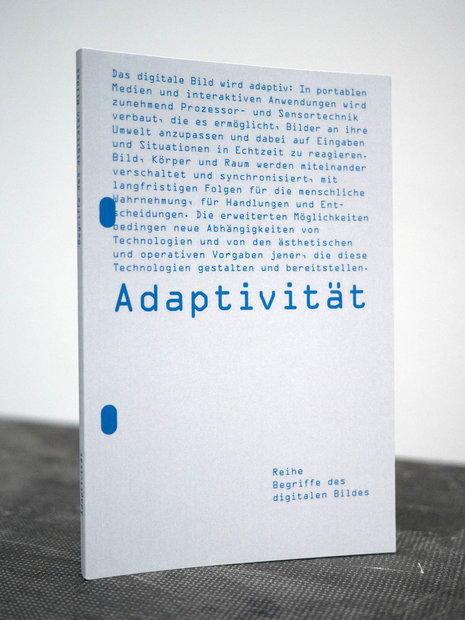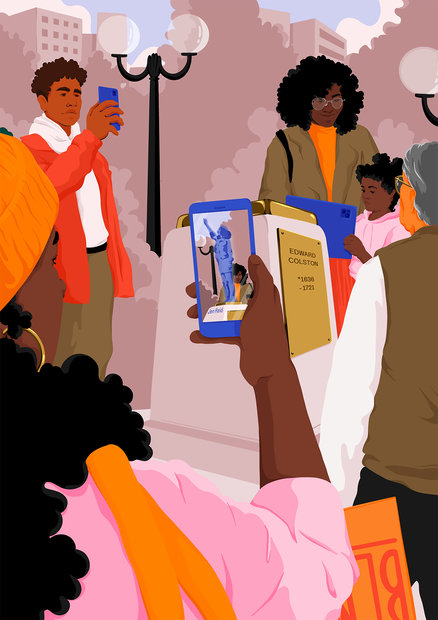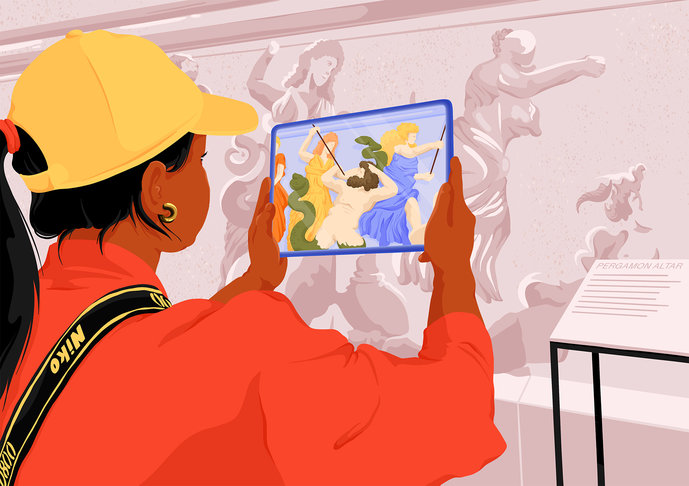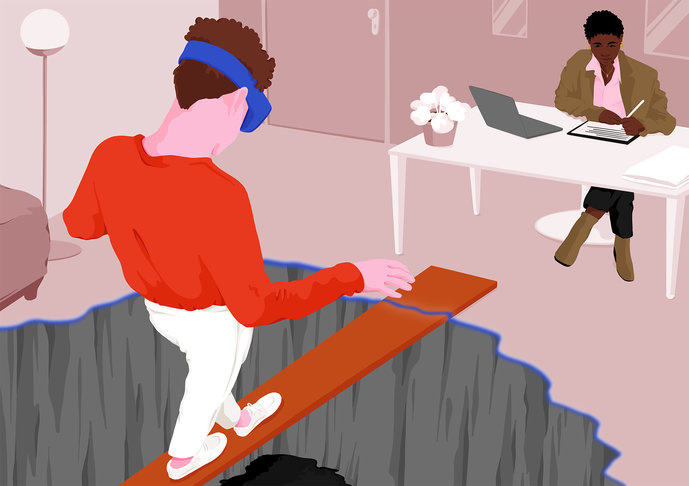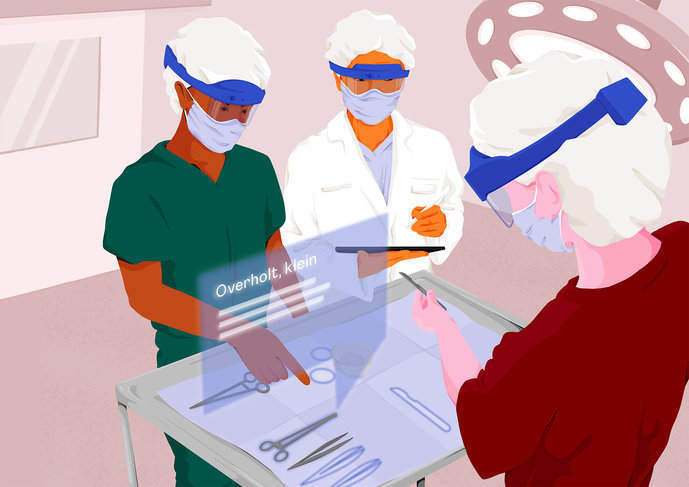26.10.2021
New publications
The digital image is becoming more adaptive: wearable media and interactive applications increasingly incorporate processor and sensor technology that allows images to adapt to their environment and respond to inputs and situations in real time. Image, body, and space are interconnected and synchronized, with long-term consequences for human perception, action, and decision-making. Expanded possibilities impose new dependencies on technologies and on the aesthetic and operational specifications of those who develop and provide those technologies.
With contributions by:
Matthias Bruhn, Kathrin Friedrich, Lydia Kähny, Matthias Planitzer, Moritz Queisner, Josephine Rais, Carmen Westermeier.
The volume appears in the series Begriffe des digitalen Bildes of the DFG Priority Program The Digital Image and is edited by Hubertus Kohle and Hubert Locher.
Details:
Bruhn M., Friedrich K., Kähny L., Queisner M.: Adaptivität. Begriffe des digitalen Bildes. Hildesheim, Munich: Georg Olms Verlag, University Library LMU Munich, 2021.
DOI: 10.5282/ubm/epub.76331free download (PDF)
ISBN: 978-3-487-16053-5order print version
And Josephine Rais illustrates the article Scenarios of adaptive imaging in cooperation with Matthias Bruhn, Kathrin Friedrich, Lydia Kähny, Moritz Queisner. The case studies illustrate the extent to which 'adaptive images' already occur in our technologized everyday life.
Diesen Beitrag Teilen auf
{"/en/aktuelles/": {"style": "aktuelles", "label": "News", "children": {"container_attrs": "data-ng-cloak data-hfg-news-filter", "style": "blackout", "/en/aktuelles/": {"style": "news", "label": "All"}, "/en/aktuelles/ausstellung": {"style": "exhibition", "label": "Exhibition"}, "/en/aktuelles/projekt": {"style": "project", "label": "Project"}, "/en/aktuelles/veranstaltung": {"style": "event", "label": "Event"}, "/en/aktuelles/kooperation": {"style": "cooperation", "label": "Cooperation"}, "/en/aktuelles/meldung": {"style": "announcement", "label": "Announcement"}, "/en/aktuelles/offene-stellen": {"style": "job-vacancies", "label": "Job vacancies"}, "/en/aktuelles/aktuelle-publikationen": {"style": "new-publications", "label": "New publications"}}}, "/en/hochschule/": {"label": "About us", "children": {"/en/hochschule/mission/": {"label": "Mission statement", "hidden": "true"}, "/en/hochschule/geschichte/": {"label": "History"}, "/en/hochschule/lehre/": {"label": "Teaching"}, "/en/hochschule/organe-und-gremien/": {"label": "Boards and committees", "children": {"/en/hochschule/organe-und-gremien/rektorat/": {"label": "Rectorate"}, "/en/hochschule/organe-und-gremien/senat/": {"label": "Senate"}, "/en/hochschule/organe-und-gremien/hochschulrat/": {"label": "University Council"}, "/en/hochschule/organe-und-gremien/gleichstellungsbeauftragte/": {"label": "Gender Equality Representative"}, "/en/hochschule/organe-und-gremien/behindertenbeauftragter/": {"label": "Representative for the Disabled"}, "/en/hochschule/organe-und-gremien/personalrat/": {"label": "Staff Council"}, "/en/hochschule/organe-und-gremien/asta/": {"label": "Students\u2019 Union"}, "/en/hochschule/organe-und-gremien/fachgruppensprecherinnen/": {"label": "Department Spokespersons"}}}, "/en/hochschule/verwaltung/": {"label": "Administration"}, "/en/hochschule/bekanntmachungen-des-rektorats/": {"label": "Announcements from the rectorate"}, "/en/hochschule/kooperationen/": {"label": "Cooperations"}, "/en/hochschule/zentrale-einrichtungen/": {"label": "Central facilities", "children": {"/en/hochschule/zentrale-einrichtungen/bibliothek": {"label": "Library"}, "/en/hochschule/zentrale-einrichtungen/studios-und-werkstaetten": {"label": "Studios and workshops"}, "/en/hochschule/zentrale-einrichtungen/ausleihe": {"label": "Loans"}}}, "/en/hochschule/foerdergesellschaft/": {"label": "Development fund"}, "/en/hochschule/presse-oeffentlichkeitsarbeit/": {"label": "Press / Public relations"}, "/en/hochschule/publikationen/": {"label": "Publications", "children": {"/en/hochschule/publikationen/jahresberichte/": {"label": "Annual Reports"}, "/en/hochschule/publikationen/informationsbroschueren/": {"label": "Information brochures"}, "/en/hochschule/publikationen/munitionsfabrik/": {"label": "Munitionsfabrik"}, "/en/hochschule/publikationen/edition-76135/": {"label": "Edition 76135"}, "/en/hochschule/publikationen/neue-folge/": {"label": "Neue Folge"}, "/en/hochschule/publikationen/reihe-hfg-forschung/": {"label": "Reihe HfG Forschung"}, "/en/hochschule/publikationen/massnahme/": {"label": "Ma\u00dfnahme"}, "/en/hochschule/publikationen/schriftenreihe-der-hfg-bei-cantz/": {"label": "cantz book series"}, "/en/hochschule/publikationen/weitere-publikationen/": {"label": "Various publications"}}}, "/en/hochschule/downloads/": {"label": "Downloads"}, "/en/hochschule/informationen-fuer-hochschulangehoerige/": {"label": "Information for University Staff and Students"}, "/en/hochschule/stellen/": {"label": "Job vacancies"}}}, "/en/studium/": {"label": "Studies", "children": {"/en/studium/fachgruppen-und-studiengange/": {"label": "Departments and courses of study", "children": {"/en/studium/fachgruppen-und-studiengange/ausstellungsdesign-und-szenografie/": {"label": "Exhibition Design and Scenography"}, "/en/studium/fachgruppen-und-studiengange/kommunikationsdesign/": {"label": "Communication Design"}, "/en/studium/fachgruppen-und-studiengange/produktdesign/": {"label": "Product Design"}, "/en/studium/fachgruppen-und-studiengange/kunstwissenschaft-und-medienphilosophie/": {"label": "Art Research and Media Philosophy"}, "/en/studium/fachgruppen-und-studiengange/medienkunst/": {"label": "Media Art"}}}, "/en/studium/studieninteressierte/": {"label": "Prospective Students"}, "/en/studium/bewerbung/": {"label": "Application", "children": {"/en/studium/bewerbung/studienberatung-und-mappenberatung/": {"label": "Study and portfolio advice"}, "/en/studium/bewerbung/bewerbungsverfahren/": {"label": "Application procedure"}, "/en/studium/bewerbung/zulassung-und-eignungspruefung/": {"label": "Admission requirements and aptitude examination"}, "/en/studium/bewerbung/immatrikulation/": {"label": "Enrollment"}, "/en/studium/bewerbung/gasthoererinnen/": {"label": "Auditors", "children": {"/studium/bewerbung/gasthoererinnen/gasthoererinnen/": {"label": "Auditors"}, "/studium/bewerbung/gasthoererinnen/hoererinnen-vom-kit/": {"label": "Auditors from KIT"}}}, "/en/studium/bewerbung/informationen-fuer-internationale-bewerberinnen/": {"label": "Information for international applicants"}}}, "/en/studium/preise-und-stipendien/": {"label": "Prizes and Scholarships"}, "/en/studium/wohnen-und-leben-in-karlsruhe/": {"label": "Living in Karlsruhe"}, "/en/studium/downloads/": {"label": "Downloads"}, "/en/studium/kontakt/": {"label": "Contact"}}}, "/en/vorlesungsverzeichnis/": {"label": "University Calendar"}, "/en/forschung-und-entwicklung/": {"label": "Research and Development", "children": {"/en/forschung-und-entwicklung/forschungsfoerderung/": {"label": "Research Funding"}, "/en/forschung-und-entwicklung/forschungsprojekte/": {"label": "Research Projects"}, "/en/forschung-und-entwicklung/promovieren/": {"label": "Doctorates"}, "/en/forschung-und-entwicklung/promotionsprojekte/": {"label": "Doctoral Projects"}, "/forschung-und-entwicklung/orc/": {"label": "Open Resource Center", "children": {"/forschung-und-entwicklung/orc/auda/": {"label": "AuDA"}}}}}, "/en/international/": {"label": "International", "children": {"/en/international/incomings": {"label": "Incomings", "children": {"/en/international/incomings/informationen-fuer-internationale-bewerberinnen/": {"label": "Information for international applicants"}, "/en/international/incomings/erasmus/": {"label": "Exchange Students (Erasmus+/Overseas)"}, "/en/international/incomings/praktische-informationen-fuer-internationale-studierende/": {"label": "Practical information for international students"}, "/en/international/incomings/freemover/": {"label": "Free Movers"}}}, "/en/international/outgoings/": {"label": "Outgoings", "children": {"/en/international/outgoings/wege-ins-ausland/": {"label": "Going abroad"}, "/en/international/outgoings/foerdermoeglichkeiten/": {"label": "Funding opportunities", "children": {"/en/international/outgoings/foerdermoeglichkeiten/erasmus/": {"label": "Erasmus+"}, "/en/international/outgoings/foerdermoeglichkeiten/promos/": {"label": "PROMOS"}, "/en/international/outgoings/foerdermoeglichkeiten/baden-wuerttemberg-stipendium/": {"label": "Baden-W\u00fcrttemberg Scholarship"}, "/en/international/outgoings/foerdermoeglichkeiten/freemover/": {"label": "Free movers"}}}, "/en/international/outgoings/partnerhochschulen/": {"label": "Partner universities", "children": {"/en/international/outgoings/partnerhochschulen/erasmus-partnerhochschulen/": {"label": "Erasmus partner universities"}, "/en/international/outgoings/partnerhochschulen/internationale-austauschprogramme/": {"label": "International exchange programs"}}}, "/en/international/outgoings/erfahrungsberichte": {"label": "Student Experiences"}}}, "/en/international/dokumente/": {"label": "Documents"}, "/en/international/strategie/": {"label": "Strategy"}}}, "/en/kontakt/": {"label": "Contact"}, "/en/service/": {"label": "Service", "children": {"/en/service/allgemeines/": {"label": "General Information"}, "/en/service/health-and-safety/": {"label": "Health and Safety"}, "/en/service/studieninteressierte/": {"label": "Prospective Students"}, "/en/service/studierende/": {"label": "Students"}, "/en/service/beschaeftigte/": {"label": "Employees"}, "/en/service/partner-und-alumni/": {"label": "Partners and Alumni"}}}, "/en/personen/": {"label": "People"}, "/en/suche/": {"label": "Search"}, "/en/studierenden-projekte/": {"label": "Student projects"}, "https://zkm.de/en": {"label": "ZKM"}, "/en/aktuelles/corona/": {"label": "Corona measures"}}

